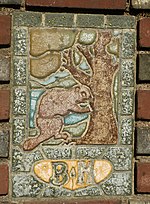Fairlawn–Nettleton Historic District
Historic districts in New Haven, Connecticut
Fairlawn–Nettleton Historic District is a state-designated historic district in New Haven, Connecticut.It is located in the Beaver Hills neighborhood of New Haven. The street boundaries are Goffe Terrace on the northeast, Osborn Avenue on the northwest, Whalley Avenue on the southwest, and Ella T. Grasso Boulevard on the southeast.
Excerpt from the Wikipedia article Fairlawn–Nettleton Historic District (License: CC BY-SA 3.0, Authors).Fairlawn–Nettleton Historic District
Whalley Avenue, New Haven
Geographical coordinates (GPS) Address External links Nearby Places Show on map
Geographical coordinates (GPS)
| Latitude | Longitude |
|---|---|
| N 41.322 ° | E -72.951 ° |
Address
Fairlawn-Nettleton Historic District
Whalley Avenue
06515 New Haven
Connecticut, United States
Open on Google Maps






